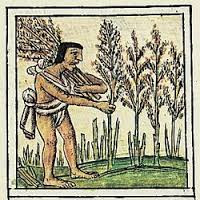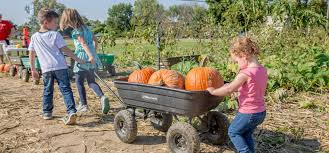PUMPKINS
Pumpkins are native to North America where seeds have be found in
Mexican graves and temples dating back five to seven thousand years ago. Up
north, pumpkins were grown by Native Americas for hundreds of years before the first European settlers
arrived here.
 |
When the Europeans "discovered" America they actually found a great civilization that had existed here for thousands of years. |
The American Indians created a farming technique called "The
three sisters". Corn was grown in the same plot as beans and squash. The
corn would grow tall and the beans would use it as a trellis. The pumpkins and
squash were planted at the base and would discourage raccoons and other
critters from eating the corn and beans.
 |
The "Threes Sisters" planting system would get wildlife to focus on the harder to eat pumpkins and squash, distracting them from the beans and corn. |
The Natives later taught this practice to the Pilgrims. Without pumpkins it is doubtful any of the Pilgrims would have survived the first long winter.
In later years the Pilgrims would carve out pumpkins, fill them with milk and bake them until they turned in a rich, flavorful custard. This tradition later became today's pumpkin pies.
 |
Sugar pumpkins are used for baking while the larger pumpkins are used mostly for display. The stems add interest to the pumpkins and your display. |
Pumpkins and other winter squash are easy to grow if you give them
their basic requirements, warm rich soil, heavy but even moisture, lots of sun
and most importantly, plenty of space to spread out and grow. If they outgrow
their space your can turn the growing tips towards where you want them to grow.
When harvesting leave at least one inch of stem attached and let your pumpkins
sit in the sun for ten days to cure them before storing them.
 |
If you want to grow a large pumpkin, remove all but one from the vines so the plant can focus all it's energy the one remaining fruit. |
Our modern Halloween tradition of carving out pumpkins began in ancient Ireland. The Celtic people believed the dead arose from their graves every year on October 31.
To ward off evil, people carved faces into rutabaga or turnips, beets or potatoes and put them in windows and at their doors. Even the name Jack-O-Lantern is derived from Irish lore and folktales.
 |
October 31 was celebrated as Samhain, marking the end of the harvest season and the being of the dark winter ahead. It was the day the dead walked the earth. |
When our Irish immigrants arrived in America they brought these
traditions with them and quickly learned pumpkins are much easier to carve out.
Today pumpkins can be found in a variety of sizes, from the massive orange pumpkins to jack-be-little, which can fit in the palm of your hand.
Today pumpkins can be found in a variety of sizes, from the massive orange pumpkins to jack-be-little, which can fit in the palm of your hand.
 |
Pumpkin craving is a creative and fun event that millions of Americans enjoy as an annual Halloween tradition. |
Color choices now start at white, then orange, and blended. There are even pumpkins with warts for folks looking for something different.
 |
With the addition of heirloom pumpkins, choices of color and textures are continuing to grow. |
Selecting a pumpkin is often a family event with everyone going to
a local farm to make their selections. When choosing your pumpkin pay attention
to the stem. Pumpkins with stems last longer; long or curved stems add
character to the pumpkin.
 |
Halloween has a centuries old history as an adult holiday. It has only recently that it has become a children's celebration with preparations and decorations starting weeks before October 31 |
A pumpkin placed by a door or in front of a house today has come
to symbolize the autumn season, good fortune and prosperity.
 |
A pumpkin placed by the front door in the autumn is a symbol of hospitality and welcome. |
Happy Halloween
Drive Extra Safe, James
Drive Extra Safe, James
 |
Although not as spooky as it used to be, millions of people still go to sleep on Halloween with one eye open. |
No comments:
Post a Comment